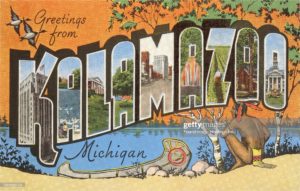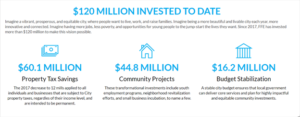Marty Levine
August 11. 2021

‘Greetings from Kalamazoo, Michigan’ large letter vintage postcard, 1930s. (Photo by Found Image Holdings/Corbis via Getty Images)
In the fall of 2016, Kalamazoo, Michigan was not unique. It, like cities larger and smaller, was faced with large budget shortfalls and was unable to spend what was needed to maintain its infrastructure and serve its residents. And then two wealthy community members stepped forward offering to help fund what city taxes could not. The city approved a memorandum of understanding with the lead donors to the Kalamazoo Foundation for Excellence (FFE). $70 million was the initial commitment and a goal of growing the Foundation to $500 million was set. With the agreement signed, the Foundation went from concept to operating entity and set about using its donated resources to “support the goals of the City of Kalamazoo, fund aspirational projects, and empower Kalamazoo residents to achieve the lives they want for themselves and their families.”
At the time, writing for Nonprofit Quarterly, I wondered “can some of the city’s financial woes be solved using philanthropic resources rather than tax revenues without damaging its democratic institutions?” Was it possible and was it right for public services to be funded in this manner without further marginalizing those who could not write large checks?
And those checks did come, and Kalamazoo and the Foundation for Excellence became close partners. They are proud that they can today cite $120 million of spending supported by Foundation resources. This has enabled Kalamazoo to reduce its property tax rate, offset its accumulated debt and make “transformational investments in… youth employment programs, neighborhood revitalization efforts, and small business incubation…”

Almost five years after this story the beginning of this story, city leaders giddily announced that donors had stepped forward and pledged to realize the Foundation’s goal by adding $400 million in new funding over the next ten years. Mayor David Anderson was euphoric when he shared this news at a July 29th ceremony. In words captured by Second Wave Southwest Michigan, he said “What will be different tomorrow other than that our hearts are lifted? We have already been doing this work. Now, due to the fact that we have generous people that live in this community, we are putting a stake in the ground. We’re putting a stake in the ground for our children, and our children’s children by creating and funding this endowment that will put us in the position of having a fund that will last in perpetuity, entirely aligned with our values in the city of Kalamazoo, to make this a great place for all of us to live. I’m a hopeful, optimistic person and whenever I get discouraged, I look to what we can do, what we can start doing now. This gives us the means to dream big.”
On the surface, it appears that the Foundation and the City formed a seamless operation. The Foundation and the City operate as one highly integrated organization. The Foundation’s Board was designed to build a strong link between the city and the Foundation. “Ten members are stakeholder directors, each representing a community interest such as healthcare, education, or business. Five are City Directors…These members include the Mayor, City Manager, two City Commissioners, and one At-Large representative from the city.” The Foundation is fully staffed by five full-time City of Kalamazoo employees who “manage the governance of the foundation and administer its programs in collaboration with department staff and community partners.” The Foundation’s website is closely linked with the city’s, making it hard to see them as unique organizations.
The impact of what Kalamazoo and the FFE have been able to do, as described by the Chronicle of Philanthropy is impressive “Last fall, city officials determined that nearly three-quarters of 145 specific actions outlined in the city’s strategic plan had been completed. These include rehabbing and building city parks, expansion of job training for teenagers, replacement of dangerous lead pipes, and sidewalk repair. In its dire times, the city had zeroed out its budget for sidewalks — not ideal when walkability has become a popular measure for a city’s livability. At the pandemic’s start last year, the city partnered with the local United Way to create…a special low-interest loan fund to help tide businesses over as they waited for state and federal aid. …The city has partnered with the Kalamazoo affiliate of the Local Initiatives Support Corporation and other nonprofits to determine how best to spend the nearly $8 million targeted for affordable housing. With that money, LISC in Kalamazoo won an additional $31 million in support from its national organization…”
In the current political situation, cash-starved cities like Kalamazoo cannot tax their way to making the kind of impact that FFE funds have allowed. A system that forces cities to fund much of their budget based on local property taxes makes cities struggle during times of economic stress and falling property values. State and Federal Governments that have bought into “trickle-down economics”, choosing to decrease taxation on the wealthy and reducing the direct support they can provide cities make the situation even more difficult. They are fortunate that they have civic-minded wealth who chose to step in.
Yet, as positive as Kalamazoo’s last five years have been I remain troubled.
Kalamazoo has a population of 75, 600. It is working for Kalamazoo, but can it work for other struggling cities. To match Kalamazoo, Dayton, Ohio would need to find donors ready to fund a $1 billion effort. Chicago will need donors ready to give it an endowment of more than $13 billion. Just the nation’s 10 largest cities will need more than $240 billion placed in their version of a Foundation for Excellence.
I shudder to do the math to expand this list to include every city, town, and village; every county, school board, and other local governmental units that share challenges like Kalamazoo.
Is their philanthropic capacity for such a staggering effort?
And, if that capacity did exist, are there enough donors like those in Kalamazoo? Are their wealthy men and women will be willing to make gifts of historic size to support elected officials and local governments to do their work without controlling the agenda and setting public policy? Are there enough of these angels committed to listening to the voice of the people rather than their own wisdom? Are there enough humble men and women who will forgo the public adulation that comes with making large gifts and having their name on buildings and organizations?
No, as optimistic as the Kalamazoo experience has been, I do think it is the way forward.
Focusing on a philanthropic answer just sidetracks us from the important work of reforming how we can fund vitally needed services in a manner that does not further harm marginalized communities. It deflects us from continuing to grapple with the accumulation of wealth and the need for a fairer and more equitable tax system. And it deflects us from grappling with ensuring our governments are effective in doing the work they must do.
This is a hard set of conversations we cannot avoid by turning our focus on creating a system of alms for the poor city.
Kalamazoo is telling us not to wait.
